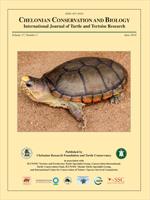The nesting ecology of Apalone spinifera in large North American rivers is largely unknown despite the wide distribution of the species in these naturally dynamic ecosystems. We describe the nesting locations, timing, behavior, and habitat of A. spinifera in relation to natural and anthropogenic factors in the Missouri River. Nesting followed annual peak river stage, mostly occurred in the afternoon when air temperatures were 25°–30°C, and did not occur when human activity was nearby. Apalone spinifera nested in June in a year with average discharge (2012), but nested 20 d later in a year with a large flood event (2011). During the average discharge year, 90% of nests were found on islands, but similar proportions of nests were found on island and mainland habitats during the flood year because many islands were inundated. Nests were mostly in mixed-gravel substrates where vegetation cover was sparse or absent. Depredation occurred only after the emergence of hatchlings (∼ 60 d after nesting) and more often on nests on the mainland than on islands. Emergence rates were ∼ 1.5 times higher in the average year than the flood year, and emergence rates were higher in mixed-gravel nests than in pure-sand nests in 2011. In artificial nests, incubation temperatures averaged ∼ 4.3°C higher in mixed-gravel than in sand substrates, and freezing temperatures in winter penetrated to depths greater than the mean egg chamber depth (7.5 cm) for up to 3 wks. Therefore, incubation might be accelerated in mixed-gravel substrates. Accelerated incubation would enhance reproductive success because freezing temperatures preclude hatchlings from overwintering in nests in our study area. Mountain snowmelt-driven hydrology, coupled with the onset of freezing temperatures in autumn, might create a temporal “runoff-freeze squeeze” that limits the successful reproduction of A. spinifera in some years. However, high runoff also scoured vegetation from shorelines where A. spinifera nested in subsequent years. Natural variation in annual discharge might therefore be crucial to conservation of A. spinifera in large rivers.
How to translate text using browser tools
21 May 2018
Factors Affecting Nesting Ecology of Apalone spinifera in a Northwestern Great Plains River of the United States
Brian J. Tornabene,
Robert G. Bramblett,
Alexander V. Zale,
Stephen A. Leathe
ACCESS THE FULL ARTICLE

Chelonian Conservation and Biology
Vol. 17 • No. 1
June 2018
Vol. 17 • No. 1
June 2018
– egg depredation
flood
incubation
Missouri River
potential freezing episode
remote camera
runoff-freeze squeeze




